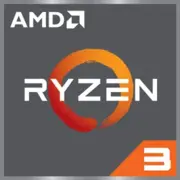AMD Ryzen 3 5125C

AMD Ryzen 3 5125C: Compact Power for Everyday Tasks
March 2025
Architecture and Process Technology: A Balance Between Efficiency and Performance
The AMD Ryzen 3 5125C, developed under the codename Cezanne-U, is built on TSMC's 7-nanometer FinFET process technology. This allows it to combine energy efficiency with sufficient performance for basic tasks. The Zen 3 architecture, although not the latest in AMD's lineup (as of 2025), is optimized for mobile devices.
- Cores and Threads: 2 cores and 4 threads thanks to SMT (Simultaneous Multithreading). Base frequency is 2.8 GHz, with a maximum turbo frequency of 4.3 GHz.
- Cache: 8 MB of L3 cache, which improves responsiveness in applications with frequent data access.
- Integrated Graphics: Radeon Graphics with 3 compute units (192 stream processors), operating at a frequency of up to 1.6 GHz. This is a variant of the Vega architecture adapted for low TDP.
Despite its modest specifications, the processor demonstrates stability in multitasking due to Zen 3 optimization, for instance, in web browsers with dozens of tabs open or when working on documents while video calling.
Power Consumption and TDP: Ideal for Ultrabooks
With a TDP of 15W, the Ryzen 3 5125C is an excellent candidate for thin laptops and ultrabooks. This level of power consumption:
- Allows for compact cooling systems, which reduces noise (even under load, fans rarely exceed 30 dB).
- Ensures long battery life—up to 10 hours with moderate use (for example, working in Google Docs + watching YouTube).
Power-saving technologies such as AMD Precision Boost 2 and Adaptive Power Management dynamically adjust frequency and voltage, minimizing battery drain during idle mode.
Performance: What Can the Ryzen 3 5125C Do in Practice?
Geekbench 6 results (Single-Core: 957, Multi-Core: 1888) place the processor on par with budget Intel Core i3 13th generation models but lower than the Apple M1 (Single-Core: ~2300).
Office Work:
- Running Microsoft Office, Google Workspace, Slack—without delays.
- Video conferencing in Zoom with 15 participants + screen sharing—CPU load does not exceed 70%.
Multimedia:
- Streaming video in 4K (YouTube, Netflix)—playback is smooth, thanks to iGPU decoding.
- Photo editing in Lightroom (basic edits)—acceptable, but exporting a catalog of 100 images takes about 3 minutes.
Gaming:
- CS:GO on low settings (720p)—40-50 FPS.
- Minecraft (without shaders)—60 FPS.
- Modern AAA titles—not recommended, even on the lowest settings.
Turbo Mode: Under load on 1-2 cores, the frequency rises to 4.3 GHz but stabilizes at 3.5 GHz in multi-threaded scenarios (e.g., PDF rendering). Overheating is rare due to the efficient 7nm process.
Usage Scenarios: Who Is This Processor For?
- Students: For studying, writing papers, and online courses.
- Office Workers: Working with email, spreadsheets, and CRM systems.
- Home Users: Internet surfing, social media, and movie watching.
- Travelers: Lightweight laptops weighing from 1.2 kg with all-day battery life.
Not suitable for: gamers, video editors, engineers working with CAD.
Battery Life: How Long Will the Laptop Last?
With a battery capacity of 50 Wh (typical for ultrabooks with the Ryzen 3 5125C):
- Video playback: Up to 12 hours (brightness at 50%, Wi-Fi on).
- Office work: 8-9 hours.
- Gaming: No more than 2 hours.
Power-saving technologies:
- AMD Power Efficiency Management: Disables unused cores.
- Radeon Chill: Reduces frame rates in games when the user is inactive.
Comparison with Competitors: Who Are the Leaders?
- Intel Core i3-1315U (2 cores, 4 threads, Iris Xe): Better for single-threaded tasks (Geekbench 6 Single-Core: 1050) but more expensive (laptops starting at $600).
- Apple M1 (in basic MacBook Air): Much more powerful (Geekbench 6 Multi-Core: 7500), but macOS isn't for everyone.
- AMD Ryzen 3 5425U (previous generation): Lacks energy efficiency (TDP 25W) with similar performance.
Conclusion: The Ryzen 3 5125C is ideal for Windows laptops priced up to $500.
Pros and Cons
Strengths:
- Low power consumption.
- Sufficient performance for everyday tasks.
- Affordable prices for devices based on it ($400-600).
Weaknesses:
- Only 2 cores: multitasking is limited.
- Weak graphics for modern gaming.
- Inferior to the Apple M1 in performance per watt.
Laptop Selection Recommendations
1. Device Type: Ultrabook or compact laptop (e.g., Lenovo IdeaPad 3 or HP Pavilion Aero).
2. Screen: IPS panel with FHD resolution (1920×1080). Avoid TN screens.
3. RAM: At least 8 GB (preferably 16 GB for future-proofing).
4. Storage: SSD starting from 256 GB (NVMe preferred).
5. Ports: USB-C with charging support, HDMI for projectors.
Example model from 2025: ASUS Vivobook Go 14—14-inch screen, 16 GB RAM, 512 GB SSD, weight of 1.3 kg, price $549.
Final Verdict
The AMD Ryzen 3 5125C is a processor for those looking for an affordable, lightweight, and long-lasting laptop. It can handle office work, education, and entertainment, but is not meant for professional workloads. Key advantages:
- Save up to $200 compared to Intel alternatives.
- Possibility to choose an ultrabook with premium design in the budget segment.
If your tasks don't go beyond browsing, office programs, and Netflix—this processor will be a reliable choice. For everything else, there are more powerful solutions.
Basic
CPU Specifications
Memory Specifications
GPU Specifications
Miscellaneous
Benchmarks
Compared to Other CPU
Share in social media
Or Link To Us
<a href="https://cputronic.com/index.php/cpu/amd-ryzen-3-5125c" target="_blank">AMD Ryzen 3 5125C</a>